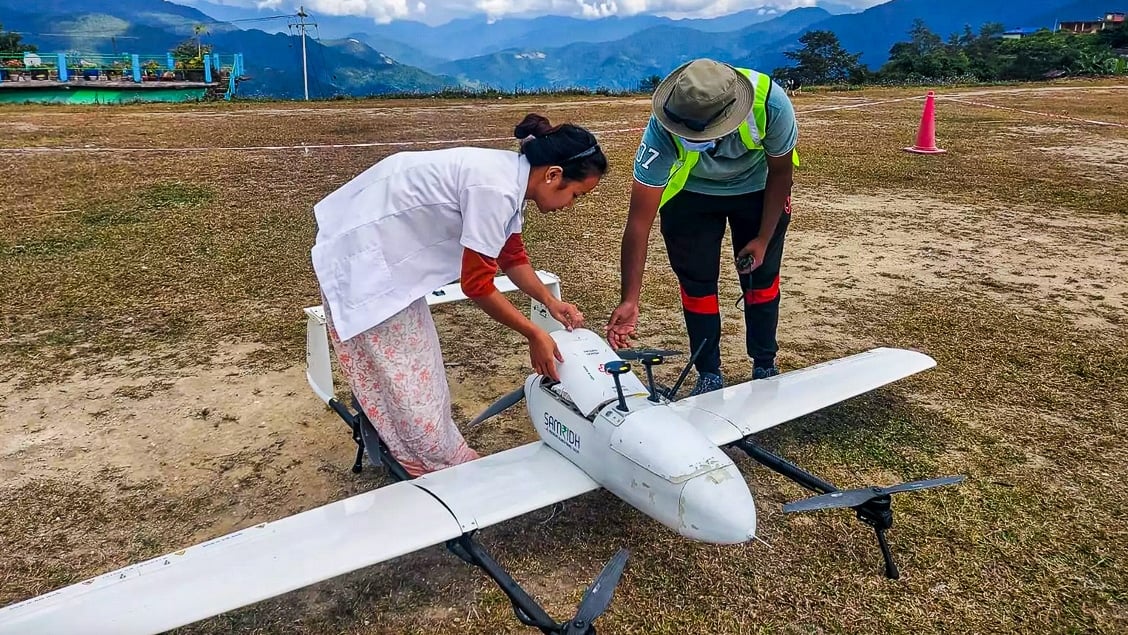Tiny AI Models Could Revolutionize Drone Operations with Onboard Intelligence

Multiverse Computing’s newly unveiled compact AI models promise to bring powerful, offline processing to edge devices, potentially transforming drones into smarter, more autonomous tools for delivery, surveillance, mapping, inspections and emergency response. Drawing from the company’s August 14 announcement, these quantum-inspired models could enable drones to handle complex tasks without cloud reliance, addressing key challenges in privacy, latency, and connectivity.
Breakthrough in Compact AI for Aerial Applications
Multiverse Computing, a Spain-based startup, introduced its Model Zoo on August 14, featuring SuperFly and ChickBrain—models compressed using proprietary CompactifAI technology. SuperFly, derived from Hugging Face’s SmolLM2 with 94 million parameters, suits highly restricted environments. ChickBrain, based on Meta’s Llama 3.1 8B with 3.2 billion parameters, outperforms its parent on benchmarks like language comprehension and mathematical reasoning, according to TechCrunch.
This technology draws from quantum physics for refined compression, as co-founder Román Orús explains: “this approach differs from traditional computer science compression methods, drawing instead from quantum physics principles for ‘more subtle and refined compression’.”
By shrinking models up to 95% while preserving accuracy, CompactifAI opens doors for embedding AI directly into drones, where size, power, and data constraints often limit capabilities.
Enhanced Capabilities for Drone Delivery
If integrated into drones, these small AI models would enable advanced onboard decision-making for delivery operations. Drones could process voice commands offline, similar to how SuperFly embeds in home appliances for tasks like “start quick wash.” In delivery scenarios, this means analyzing routes in real time, avoiding obstacles, and optimizing paths without internet.
Building on that, ChickBrain’s superior reasoning could handle dynamic variables like weather or traffic, potentially reducing delivery times by 20-30% based on current AI trends in logistics. For instance, companies like Amazon already use AI for autonomous navigation, but compact models would cut reliance on cloud servers, lowering costs to about $0.50 per delivery (from current estimates around $1-2) and enhancing privacy by keeping data local. This raises questions about safety, drone regulations and scalability—drones flying 50 miles (80 km) could manage packages up to 5 pounds (2.3 kg) more efficiently, though battery life remains a hurdle.
Autonomous Wildfire Monitoring Takes Flight
Small AI on drones could supercharge autonomous wildfire watch, allowing constant surveillance in remote areas. Equipped with ChickBrain, fixed wing drones could run image recognition offline to detect smoke or heat signatures, covering areas up to 100 square miles (259 square km) per flight.
This builds on existing systems where AI processes sensor data for early detection, but onboard models eliminate latency issues in spotty coverage zones. In California, where wildfires scorched over 4 million acres (1.6 million hectares) in 2020, such drones could alert authorities within minutes, potentially saving $1-2 billion in damages annually. The technology’s offline functionality proves crucial during network outages, enabling persistent monitoring at altitudes of 400 feet (122 meters) with thermal cameras.
Drones as Swift First Responders
In emergency situations, these models could turn drones into intelligent first responders, assessing scenes autonomously. SuperFly’s compact size fits small quadcopters, enabling them to scan for survivors or hazards without external processing.
For example, in disaster zones, AI-equipped drones have mapped flooded areas in real time, but local models would allow voice-activated commands for tasks like delivering medical supplies over 10 miles (16 km). This capability echoes deployments in hurricanes, where response times dropped by 40% with AI assistance. Economic implications include reduced operational costs—around $500 per mission versus $2,000 for manned alternatives—while regulatory shifts, like FAA approvals for beyond-visual-line-of-sight flights, would accelerate adoption.
Implications for Drone Warfare
The compact AI’s potential extends to military applications, as seen in Ukraine’s drone operations. If applied, models like ChickBrain could enable swarms to identify targets offline, enhancing precision in contested environments.
In Ukraine, AI has guided drones for strikes covering 20-30 miles (32-48 km), disrupting supply lines with 70% accuracy rates. Onboard processing would mitigate jamming risks, allowing autonomous navigation and decision-making. However, this raises ethical questions about escalation—compact AI could lower barriers to entry for non-state actors, prompting calls for international regulations. Economically, it might reduce costs from $10,000 per advanced drone to under $5,000, shifting warfare dynamics.
Multiverse’s partnerships with tech giants like Apple and HP, backed by $250 million in funding (approximately €225 million as of August 2025), position these models for rapid integration. Available via AWS APIs, they address on-device AI demands, potentially reshaping drone industries by balancing innovation with practical constraints. As adoption grows, professionals should monitor regulatory updates to harness these advancements safely.
Discover more from DroneXL.co
Subscribe to get the latest posts sent to your email.
Check out our Classic Line of T-Shirts, Polos, Hoodies and more in our new store today!

MAKE YOUR VOICE HEARD
Proposed legislation threatens your ability to use drones for fun, work, and safety. The Drone Advocacy Alliance is fighting to ensure your voice is heard in these critical policy discussions.Join us and tell your elected officials to protect your right to fly.
Get your Part 107 Certificate
Pass the Part 107 test and take to the skies with the Pilot Institute. We have helped thousands of people become airplane and commercial drone pilots. Our courses are designed by industry experts to help you pass FAA tests and achieve your dreams.

Copyright © DroneXL.co 2025. All rights reserved. The content, images, and intellectual property on this website are protected by copyright law. Reproduction or distribution of any material without prior written permission from DroneXL.co is strictly prohibited. For permissions and inquiries, please contact us first. DroneXL.co is a proud partner of the Drone Advocacy Alliance. Be sure to check out DroneXL's sister site, EVXL.co, for all the latest news on electric vehicles.
FTC: DroneXL.co is an Amazon Associate and uses affiliate links that can generate income from qualifying purchases. We do not sell, share, rent out, or spam your email.


















